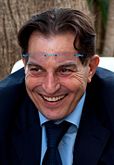Sicilian regional election, 2012
|
|
|||||||||||||||||||||||||||||
|---|---|---|---|---|---|---|---|---|---|---|---|---|---|---|---|---|---|---|---|---|---|---|---|---|---|---|---|---|---|
|
|||||||||||||||||||||||||||||
|
All 90 seats to the Sicilian Regional Assembly 46 seats needed for a majority |
|||||||||||||||||||||||||||||
| Turnout | 47.42% | ||||||||||||||||||||||||||||
|
|||||||||||||||||||||||||||||
|
|||||||||||||||||||||||||||||
Raffaele Lombardo
Movement for the Autonomies
Rosario Crocetta
Democratic Party
The Sicilian regional election of 2012 for the renewal of the Sicilian Parliament and the election of the President of Sicily was held on 28 October 2012. It was a snap election, following the resignation of President Raffaele Lombardo for judicial and financial reasons.
The election was competed by ten candidates from newly reshuffled political alliances, and is expected to be an unusually close race. The winner of the election was Rosario Crocetta, candidate for a centre-left alliance of Democratic Party and the Union of the Centre.
The Sicilian Parliament is elected with a mixed system: 80 MPs are chosen with a form of proportional representation using a largest remainder method with open lists and a 5% threshold, while 10 MPs are elected with a block voting system with closed lists.
Source: Sicilian Region
Following the result of the election, Crocetta was elected as president of Sicily, which turned out to be surprising in what was considered the strongest conservative stronghold of Italy. As he did not have a full majority in the Sicilian assembly, Crocetta decided to form a minority government with the support of the Five Star Movement in a number of shared legislative acts.
...
Wikipedia



